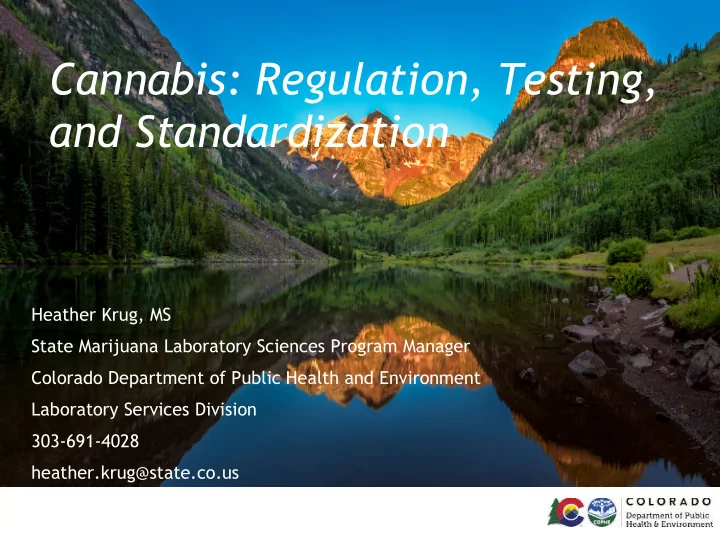

Cannabis: Regulation, Testing, and Standardization Heather Krug, MS State Marijuana Laboratory Sciences Program Manager Colorado Department of Public Health and Environment Laboratory Services Division 303-691-4028 heather.krug@state.co.us
Legal Cannabis Colorado has legalized three types of cannabis: • Industrial Hemp - authorized by US FARM Bill and CO legislation enacted in 2013 [C.R.S. 35-61-101] • Medical Marijuana – (requires physician recommendation) - voter initiative approved in 2000; State Constitution - Amendment 20 • Retail Marijuana - (adult use over age 21) - voter initiative approved in 2013; State Constitution - Amendment 64
Regulatory Authority Industrial Hemp Medical Marijuana Retail Marijuana
National Status
Need for Standards Why is standardization needed in the cannabis industry? Most importantly - public heath and safety. • Variability in: • Product types (including additives and • ingredients). • Quality/manufacturing practices. Testing. • Labeling. • Reducing consumer and industry confusion. •
Orally Consumed Products
Concentrates
Topicals
Other Products Many unexpected products appeared on the market.
Manufacturing Practices Many states do not require conformity to specific standards such as cGMP or ISO. Regulations typically contain only some components. Implications: • Lacking detailed records. • Inadequate training of staff. • • Misapplication of pesticides. Sample adulteration. • Ingredients/additives and supplies not verified. • Lack of complete safety profile of product. •
Testing and Labeling Required laboratory testing is intended to ensure • final products are free of harmful contaminants and ensure label accuracy, protecting patients and consumers. However, end-point testing alone cannot ensure • product safety. • Further, testing and labeling requirements vary significantly from state to state for marijuana products. Hemp products are currently largely unregulated. •
Testing Variability Compliance Testing Requirements (Flower) Potency Micro Mycotoxin Heavy Residual Pesticides Water Moisture Metals Solvents Activity Content Colorado X X X X Maryland X X X X X X X Oregon X Random X X X Compliance Testing Requirements (Processed Products) Potency Micro Mycotoxin Heavy Residual Pesticides Water Moisture Metals Solvents Activity Content Colorado X X X X Maryland X X X X X Oregon X Random X X
Laboratory Methods Standard cannabis testing methods largely don’t • exist. Labs develop their own in-house methods. • Staff experience, product type, and required testing • result in different methodologies and processes in labs.
Conformity Assessment Why is conformity assessment needed? Consistency in production/manufacturing. • Application of quality assurance in supply chain • and manufacturing practices. Confidence in lab results. • • Independent assessment of lab competence. Data defensibility. • Consumer clarity and confidence. • Mitigates risks to public health and safety. •
Colorado’s Progress ISO 17025 accreditation requirement added Jan • 2019. Testing varies depending on intended use of the • product. Manufacturers of higher risk products such as nasal • sprays have additional requirements such as 3 rd party audits, master formulation and batch manufacturing records, and equipment verification. • Marijuana Science and Policy Work Group Regulation change: required recall plans and • corrective/preventative action
Colorado’s Progress Nasal sprays, MDIs, suppositories, and vaporizer delivery systems: Ingredient/additive restrictions – FDA inactive • ingredient database for the route of administration Required ingredient verification through testing • and/or COAs. Additional labeling requirements to include additives • and the statement “Not approved by the FDA.” Colorado Hemp Advancement and Management Plan (CHAMP)
International Standardization • AOAC Cannabis Analytical Sciences Program (CASP) Developing standard analytical methods for • cannabis testing. ASTM – Committee D37 on Cannabis • Developing standards to include horticulture, QMS, • processing, security and transportation, personnel, cannabis devices, and testing.
• The cannabis industry is innovative and growing rapidly. Regulation is continuously evolving to keep up. • State cannabis regulatory testing and manufacturing requirements struggle to encompass all the Conclusions possible risks due to the variety of cannabis product types, modes of use, and ingredients/additives. • Federal guidance is limited and in early stages.
• Standardization in production, processing, manufacturing, and testing is necessary to ensure consistent, safe products for patient and consumer use. Conclusions • Conformity assessment to these standards is critical to ensuring adherence to these standards. • Provides benefits and protections to both the industry and to public health and safety.
Thank You!
Recommend
More recommend